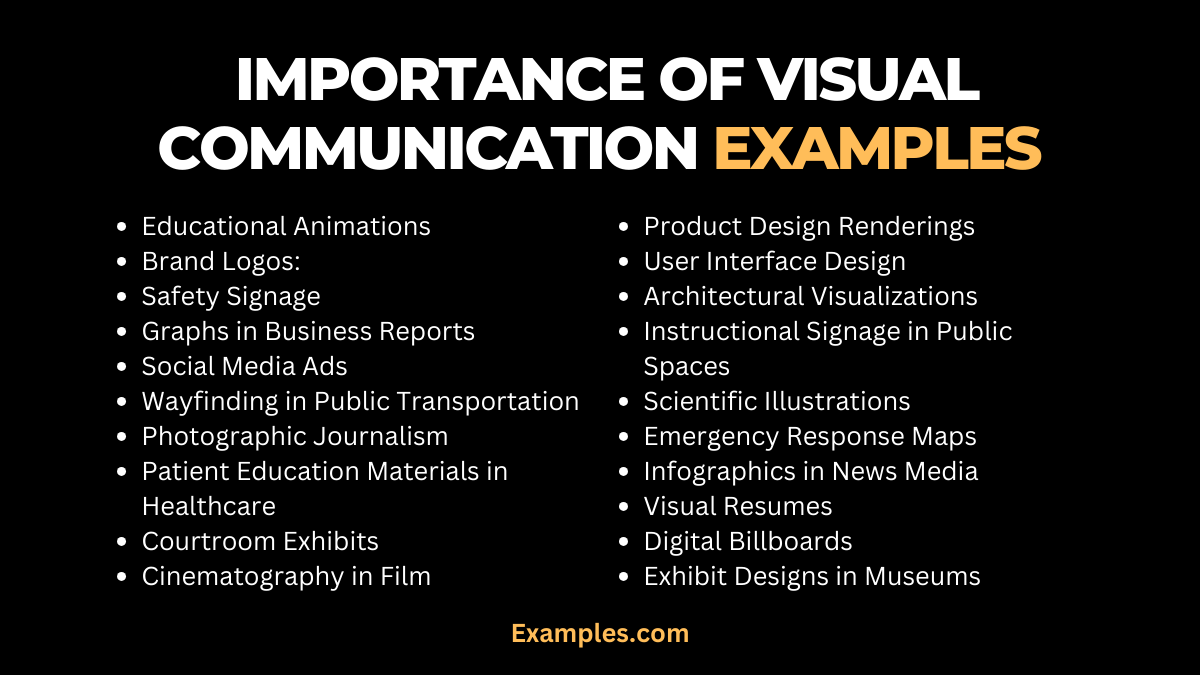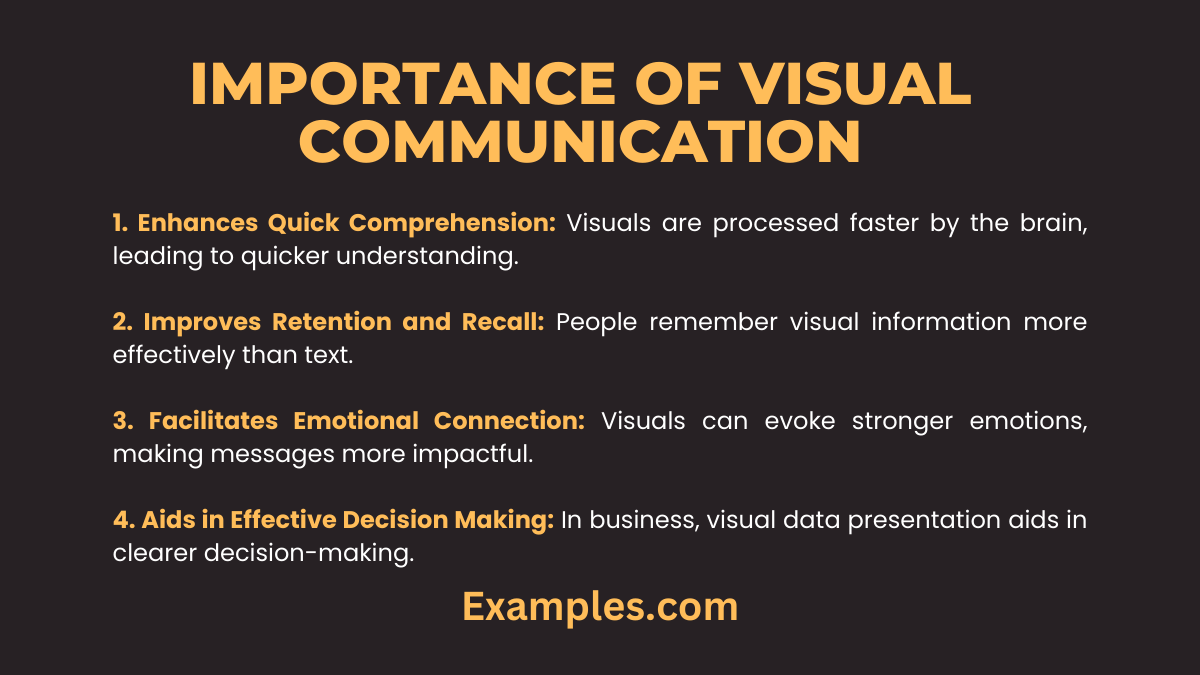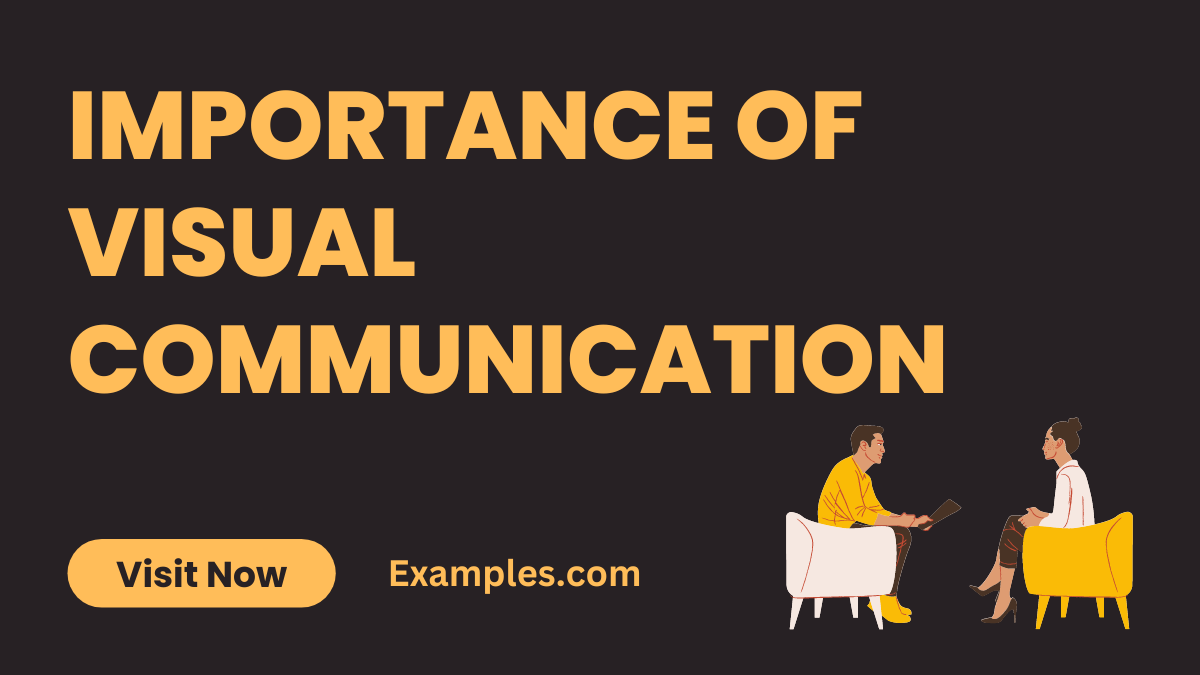Importance of Visual Communication
The importance of visual communication cannot be overstated in our increasingly digital world. This complete guide delves into the essence of visual communication, offering rich, illustrative communication examples and practical insights. From business strategies to educational methodologies, visual communication revolutionizes how we share and interpret information. Its versatility and impact span across multiple domains, demonstrating its pivotal role in enhancing understanding, engagement, and effectiveness. This guide is designed to explore these aspects, providing a comprehensive understanding enriched with real-world examples.
Download Visual Communication PDF
What is Importance of Visual Communication?

The importance of visual communication lies in its ability to convey information and ideas effectively using visual elements like images, graphs, and videos. This form of communication is crucial as it enhances understanding, engagement, and retention more than verbal or written methods alone. Visual communication is particularly significant in today’s digital age, where visual content is more prevalent and impactful. It plays a key role in various fields, including education, marketing, and design, making complex information accessible and appealing to a wider audience.
20 Importance of Visual Communication Examples

In the digital era, the importance of visual communication is more prominent than ever, bridging the gap between complexity and clarity. It encompasses various types of visual communication, each tailored to specific contexts and audiences. From marketing to education, visual communication conveys information efficiently, making it an invaluable skill in numerous professions. Here are 10 unique examples that highlight the versatility and effectiveness of visual communication:
- Educational Animations: Simplify complex subjects for students. Visual communication in education leverages animations to make learning more interactive and engaging.
- Brand Logos: Convey a company’s identity instantly. Visual branding uses logos to communicate a brand’s values and ethos.
- Safety Signage: Provide critical information quickly. Essential in workplaces, safety signage is a key example of visual communication in the workplace.
- Graphs in Business Reports: Simplify data interpretation. Visual data interpretation involves using graphs to present complex business data clearly.
- Social Media Ads: Capture attention and convey messages rapidly. Visual communication in the media utilizes eye-catching graphics in social media advertising.
- Wayfinding in Public Transportation: Guide passengers effectively. Visual communication in public spaces is exemplified by clear wayfinding signage in transit systems.
- Photographic Journalism: Tell stories powerfully. Visual communication in photography plays a crucial role in journalistic storytelling.
- Patient Education Materials in Healthcare: Simplify medical information. Visual communication in healthcare involves creating easy-to-understand patient materials.
- Courtroom Exhibits: Aid in legal explanations. Visual aids in legal settings help in clarifying complex case details.
- Cinematography in Film: Convey narratives visually. The art of visual storytelling in cinema uses visual elements to tell compelling stories.
- Product Design Renderings: Offer a realistic preview of products before manufacturing. In visual communication in business, renderings help stakeholders visualize the final product.
- User Interface Design: Facilitates user interaction with software and applications. The visual communication vs graphic design dynamic is crucial in creating user-friendly interfaces.
- Architectural Visualizations: Transform blueprints into understandable visual formats. Visual communication in architecture plays a key role in client presentations and project planning.
- Instructional Signage in Public Spaces: Guide actions and behaviors in communal areas. Examples include instructions in parks or public facilities, demonstrating how to use visual communication effectively.
- Scientific Illustrations: Aid in the understanding of complex scientific concepts. This is a critical aspect of visual communication in education, especially in higher learning.
- Emergency Response Maps: Provide clear directions during crises. This is a vital application of visual communication in the workplace for safety and preparedness.
- Infographics in News Media: Summarize news stories visually. Visual communication in the media often employs infographics for concise and impactful news delivery.
- Visual Resumes: Showcase professional skills and experience creatively. This modern twist on traditional resumes is an emerging trend in visual communication jobs, careers, salaries.
- Digital Billboards: Capture attention in high-traffic areas. In visual marketing, digital billboards are used for dynamic and engaging advertising.
- Exhibit Designs in Museums: Enhance visitor learning and engagement. Visual communication in museums employs exhibit design to educate and intrigue visitors.
Visual Communication Skills in Education
In the realm of education, visual communication skills play a crucial role in enhancing the teaching and learning experience. These skills involve using visuals like diagrams, charts, and videos to make educational content more engaging and easier to understand. Educators leverage these skills to explain complex concepts, while students use them to better absorb and retain information. This approach aligns with the importance of visual communication in fostering a more interactive and effective learning environment.
- Educational Posters: Visualize key concepts in classrooms.
Example: Display a periodic table poster in a chemistry class. - PowerPoint Presentations: Enhance lectures with visuals.
Example: Use a PowerPoint with relevant images to explain a historical event. - E-Learning Modules: Incorporate interactive graphics.
Example: Design e-learning modules with infographics for distance education. - Scientific Diagrams: Explain complex scientific processes.
Example: Use a well-illustrated diagram to teach the human digestive system. - Student-Created Visual Projects: Encourage visual expression.
Example: Assign projects where students create their own infographics on a chosen topic.
Visual Communication Skills for Business
Visual communication skills for business are essential for effective internal and external corporate communication. These skills are used to create impactful presentations, engaging marketing materials, and clear data visualizations. Proficiency in visual communication enhances brand messaging, facilitates better stakeholder understanding, and supports efficient decision-making processes, underlining the visual communication vs graphic design dynamic in the corporate world.
- Business Infographics: Present complex data visually.
Example: Use an infographic to break down the company’s annual financial report. - Corporate Video Content: Engage stakeholders with video.
Example: Produce a corporate culture video for the company website. - Branded Visual Content: Strengthen brand identity.
Example: Develop consistent visual branding across all marketing materials. - Interactive Dashboards: Monitor business performance.
Example: Implement an interactive dashboard for real-time sales tracking. - Visual Business Proposals: Make pitches more engaging.
Example: Enhance business proposals with charts and visual summaries.
Visual Communication Skills for Students
Visual communication skills for students are essential in today’s dynamic educational landscape. These skills help students in organizing and presenting information creatively and effectively. They are crucial for academic presentations, understanding complex subjects, and developing visual literacy. Mastery of visual communication enhances learning experiences, fosters creative expression, and prepares students for a visually-oriented world, underlining the significance of how visual communication works in modern education.
- Mind Maps for Study: Organize study material visually.
Example: Create a mind map for biology topics. - Student-Made Videos: Enhance project presentations.
Example: Produce a short documentary for a history assignment. - Visual Aids in Reports: Make written assignments more engaging.
Example: Include charts and graphs in a research paper. - Poster Projects: Communicate research findings.
Example: Design an informative poster for a science fair. - Digital Portfolios: Showcase creative work.
Example: Develop a digital portfolio to display art projects.
Why is Visual Communication Important?

The importance of visual communication lies in its unparalleled ability to convey messages quickly, clearly, and effectively. This form of communication utilizes visual elements, such as images, symbols, and videos, to share information. It transcends language barriers, making it a universal method for conveying ideas. In today’s digital age, where visual content dominates, understanding and implementing effective visual communication is crucial across various sectors including business, education, healthcare, and media.
- Enhances Quick Comprehension: Visuals are processed faster by the brain, leading to quicker understanding.
- Improves Retention and Recall: People remember visual information more effectively than text.
- Facilitates Emotional Connection: Visuals can evoke stronger emotions, making messages more impactful.
- Aids in Effective Decision Making: In business, visual data presentation aids in clearer decision-making.
- Breaks Down Complex Information: Complex ideas can be simplified and made accessible through visuals.
- Boosts Engagement: Visual content is more engaging than textual information.
- Supports Accessibility: Essential in contexts like sign language and educational aids for diverse learning needs.
- Encourages Creativity: Allows for creative expression in fields like marketing and design.
How To Use Visual Communication and Why It Matters?
Knowing how to use visual communication effectively is crucial in today’s visually-centric environment. It involves selecting the appropriate visual tools and tailoring them to your audience for maximum impact. Whether it’s in marketing, education, or corporate communication, visual communication has the power to transform the way messages are conveyed and perceived.
- Select the Right Visual Tools: Choose visuals like images, infographics, or videos that best suit your message.
- Understand Your Audience: Customize your visual approach based on your audience’s preferences and needs.
- Keep It Simple and Clear: Avoid clutter in your visuals to maintain clarity.
- Use Color and Design Strategically: Utilize colors and design elements to enhance the visual appeal and effectiveness of your message.
- Stay Current with Visual Trends: Keep abreast of the latest trends in visual communication to stay relevant.
- Evaluate and Adapt: Continuously assess the effectiveness of your visual strategies and be willing to make adjustments.
- Incorporate Technology: Utilize the latest digital tools and platforms for creating and sharing visual content.
- Be Culturally Sensitive: Ensure your visuals are appropriate and respectful of cultural differences.
What is the Power of Visual Communication?
The power of visual communication lies in its ability to convey complex messages quickly and memorably, enhancing understanding and engagement.
Why are Visual Elements Important in Communication?
Visual elements are crucial as they grab attention, aid in faster comprehension, and improve memory retention, making communication more effective.
What does Visual Communication Teach?
Visual communication teaches how to effectively convey messages through imagery, fostering better understanding, creativity, and audience connection.
In conclusion, the importance of visual communication is undeniable in our increasingly visual-centric world. It enhances understanding, engagement, and retention, transcending language barriers and simplifying complex information. Its power lies in its universal appeal and efficiency, making it a vital skill across various fields. Mastering visual communication is key to effective expression and interpretation in today’s digital landscape.
Visual communication is an indispensable tool in our visually dominant world, essential in fields ranging from education to corporate branding. Its ability to convey complex information effectively and engagingly makes it a crucial skill in the digital age. Further exploration into the practical applications of visual communication can be found in the University of Florida’s publication, which offers detailed insights University of Florida Extension.
Additionally, for a deeper academic understanding, consider the extensive research presented in Lindenwood University’s theses, which delve into the nuances and impacts of visual communication Lindenwood University Digital Commons.
These resources provide valuable extensions to the comprehensive guide, enhancing readers’ knowledge and application of visual communication skills.



